As a birdwatcher, it is not easy to keep track of all the nuanced differences between different birds with similar appearance but this often denies us our chance to document a certain bird species well. So, how do you recognize a black bird with a yellow bird?
A black bird with a yellow beak could be from either of the families; Thrushes, Mynas, or Eagles. The best way to recognize them is to observe their size and their distinctive characteristics such as if you notice the difference in size, you can instantly tell an Indian black bird from a Black Thrush despite both of them having black bodies with bright yellow beaks.
For your convenience, I have compiled a list of some of the most commonly occurring birds in North America along with their doppelgangers in other continents with a note on their basic appearance and behavior.
This will help you recognize the species the next time you happen to see any one of them.
Identifying A Black Bird With Yellow Beak ?
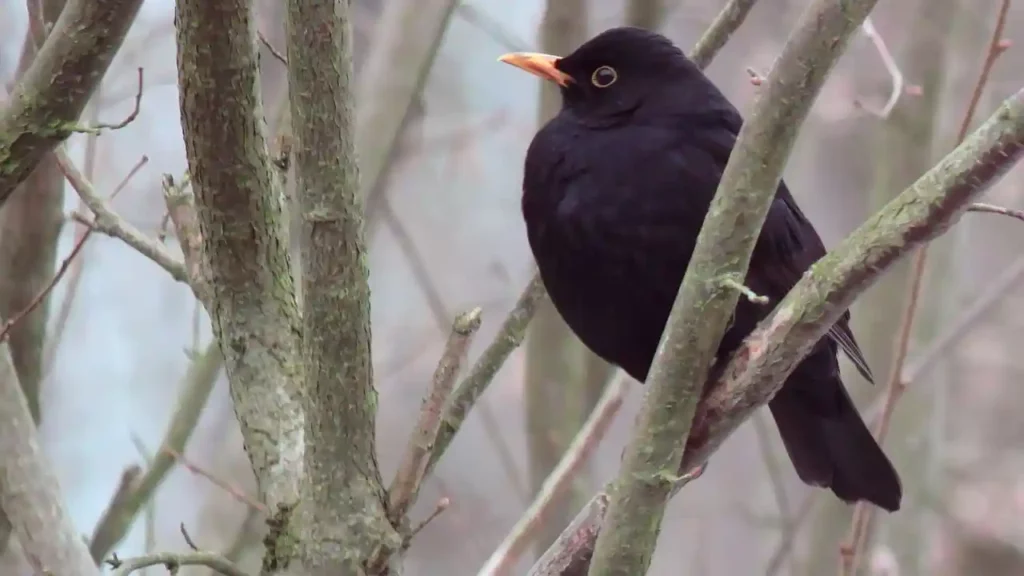
Before reading about the birds in details, we have to learn about some of the factors which are of vital importance to us for confirming the distinction between two species.
These include size, color, habitat, shape of the beak and the season.
When you keep these parameters in mind while learning about the plethora of birds, you can arrive at the right answer whenever you spot a familiar looking black bird.
So, keep the following pointers in mind:
- Size– Whether the bird is small-sized, mid-sized or large-sized.
- Plumage– Is the colouration uniform or there are any streaks present?
- Habitat– Is the region riparian, woody or grassland?
- Shape of the beak– Straight, curved, pointed or blunt?
- Season– This factor is essential in determining the migratory species.
Black Thrush
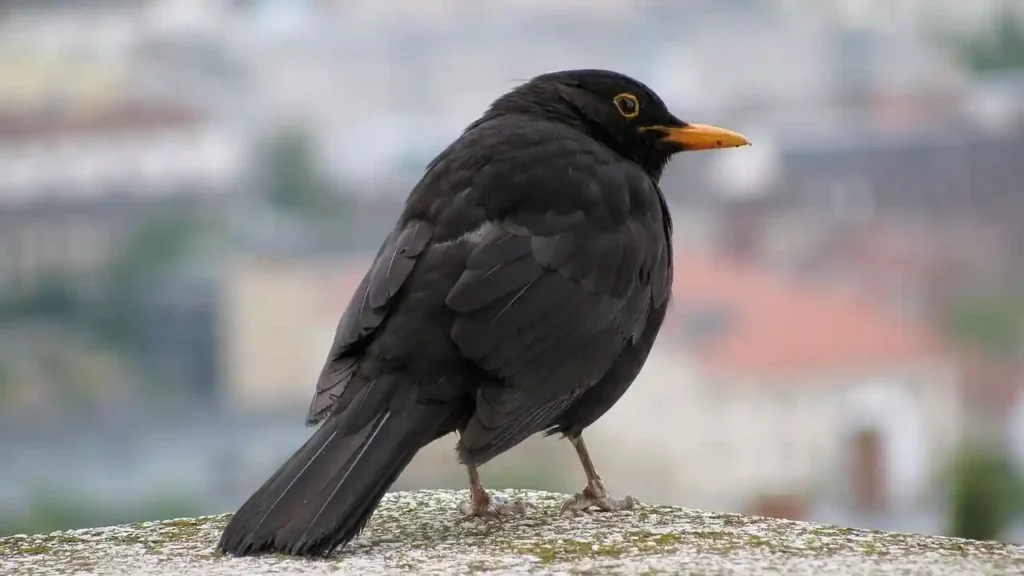
Black Thrush has a shimmering black plumage, a medium stature, and a brilliant yellow beak. Brownish tints can be seen on the female Black Thrush.
Mexico and Central America are the natural habitats of the Black Thrush where they consume berries, bugs, worms, tiny reptiles, lizards, and frogs.
Their primary habitats are low- lying woods, however they can occasionally be seen in lawns or meadows close to populated areas where they graze on the grass on bugs and other tiny insects.
Although it’s not the most frequent bird to observe in the region, the Black Thrush is undoubtedly one of the more intriguing species given their appearance and behavior.
Common Myna
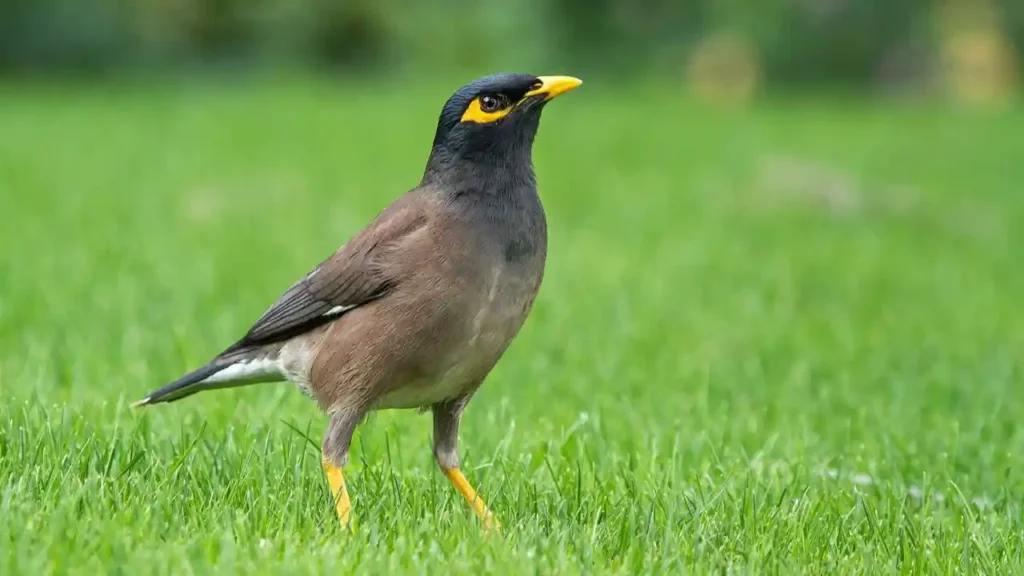
Common Mynas are generally observed in cities, where they dangle from trees or wire baskets, construct their homes in building rooftops or canopies, or both.
Despite being native to South Asia and Australia, this species of bird is now widespread due to human introductions.
It is dark in color with dark brown plumage a black hood covering its head and a yellow mark around its eye. Its beak is a brilliant yellow color.
Their ideal environment is close to rivers and streams or any area with an abundance of food. They are also omnivores, meaning they consume both plant and animal stuff.
They will consume fruit, but their primary diets are insects including grasshoppers, wasps, locusts, and flies.
Yellow-Billed Chough
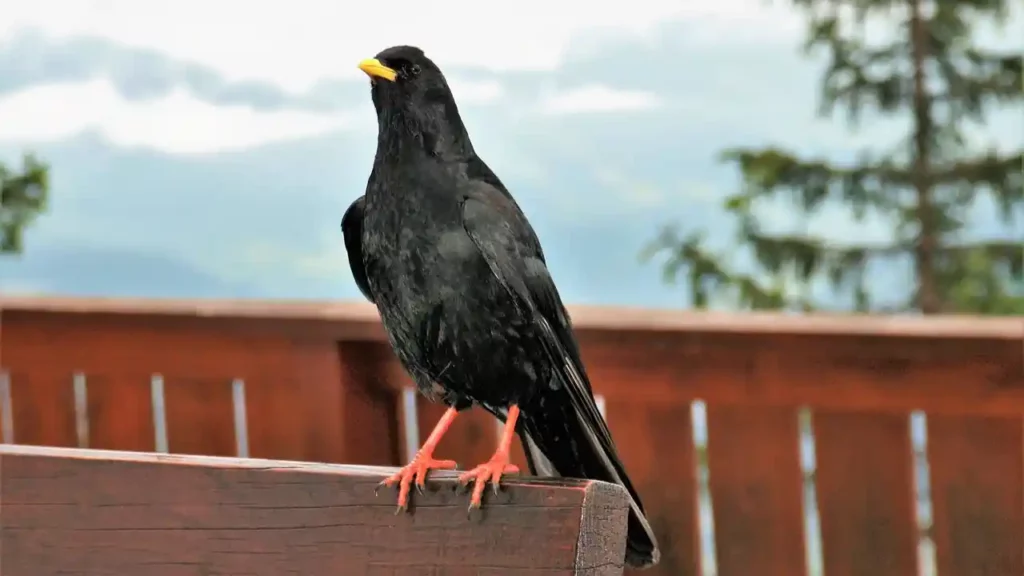
The glistening black bodied and red legged, yellow-billed chough, often known as the Alpine chough, belongs to the crow family.
South Africa, South Island, Australia, New Zealand, and Southern Europe are home to this type of bird.
There are sufficient coastal cliffs nearby for nesting, therefore they reside in meadows or dry scrubland close to the ocean.
Their main food sources include spiders, insects, termites, hornet, and bee larvae. This bird’s loud cry, which has a “keeow”-like sound, is its most recognisable characteristic.
European Starling
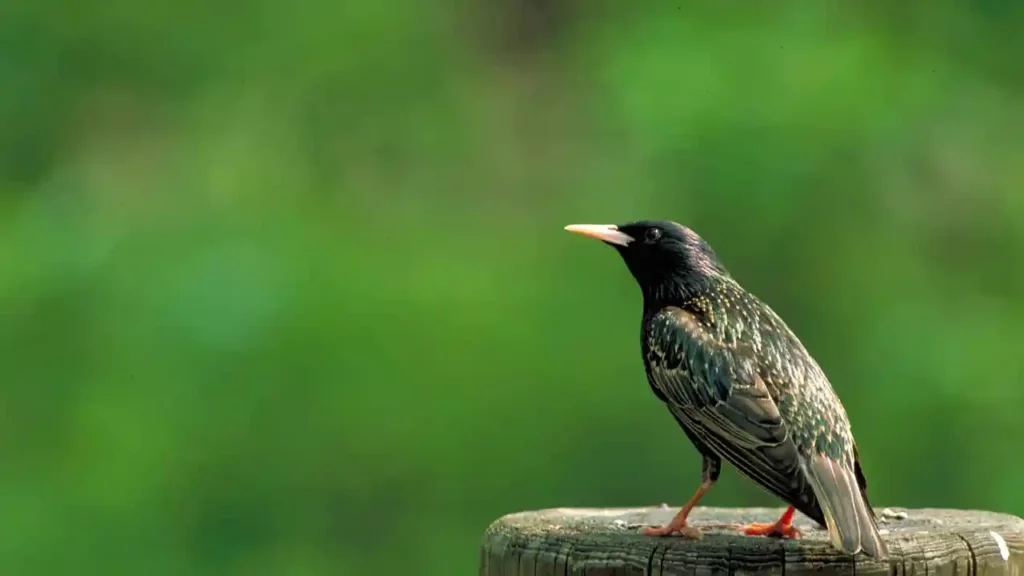
European Starlings have quite a yellow beak and black dazzling plumes. They consume grains, berries, insects like bugs and worms, as well as occasionally small vertebrates like rodents and bird eggs.
The European starling was once only found in Europe, but it has subsequently been spread to several other locations throughout the globe.
These birds are frequently observed bouncing across the ground in search of food, and sometimes, they may sit high in treetops to rest.
Nowadays, European Starlings are common throughout different geographies. In towns, cities, parks, and all kinds of areas, you may spot this bird.
African Thrush

The African thrush inhabits a variety of woody environments, such as forest edges, riparian woodland, scrub farming, playgrounds, and lawns.
The African thrush has considerable regional diversity. The underparts of this common thrush might be whitish, grey, or reddish colored, whereas the upperparts are typically gray-brown.
Across the board, the bright yellow bill is the only physical characteristic that is uniform.
Their song is made up of a lovely, fluid succession of conversational whistles and trills that may go on indefinitely without pausing.
It is very similar to the Abyssinian Thrush, but found in regions at lower elevations, lighter overall, and with a softer yellow beak.
The African thrush is cautious and reclusive, choosing to remain under cover, and is typically seen alone or in couples.
However, it will come out and cluster around fruiting trees. Forages typically on the ground, raking up leaves and rummaging through bushes. Akin to the song thrush in Europe, it is known to eat in the open when unbothered or acclimated to people.
Hill Myna

Hill Myna is indigenous to Indochina, southern China, Thailand, Malaysia, and the Philippines as well as eastern India.
Nevertheless, this species has been imported and naturalized with success in various locations, especially Florida, Hawaii, Japan, and Puerto Rico.
It lives in the majority of the evergreen and wet deciduous forests, jungles, and other habitats within its range because it loves places with high levels of rainfall and humidity.
It looks shiny black with different undertones in the feathers. The tail is glossy turquoise, while the remainder of the body is colored green and the head, neck, and breast have a purple shine.
On primaries 3 through 9, the wings are black with a white spot.
Although the Hill myna often consumes fruits, nectar, insects, and lizards are also part of its diet.
The most popular foods are figs, next berries and seeds from various trees and plants, in that order.
Bald Eagle

Bald eagles are huge, carnivorous predators with a hooked golden beak and brown torso and feathers.
Young bald eagles have a radically different appearance from grownups; they are almost totally brown with sporadic white patterns on their chest and bottom part of their wings.
The juvenile’s tail and head turn white as it ages, and the beak changes from a deep brownish-black to a yellow hue.
Fish is their favorite food. Because they are promiscuous hunters, these birds will eat everything they can capture, even dead birds and rodents, in the absence of fish.
Bald eagles eat carrion since they are scavengers. Depending on the situation, bald eagles may even steal food from humans. Bald eagles live alone but are monogamous birds.
Bald eagles keep the same mating couple year after year even though they travel alone throughout the winter and migration.
Toco Toucan

The Toco Toucan (Ramphastos toco) largest and perhaps the most familiar of the toucan family.
A sizable portion of central and eastern South America contains environments where it may be found. In zoos, it is frequently on display.
The toco toucan is the largest species of toucan, and it has the longest beak of any bird in relation to its overall size.
The most distinguishing characteristic of R. toco is its enormous yellow-orange colored beak, which has a conspicuous black pattern at the end of the yellow bill part.
This species of toucan exhibits sexual dimorphism. Male and female physical characteristics can be distinguished through measurements and inspections.
Usually, mature male toco toucans are bigger than adult females. Due to their duller hues and shorter bills, juveniles are easily distinguished from adults.
Yellow-legged Thrush
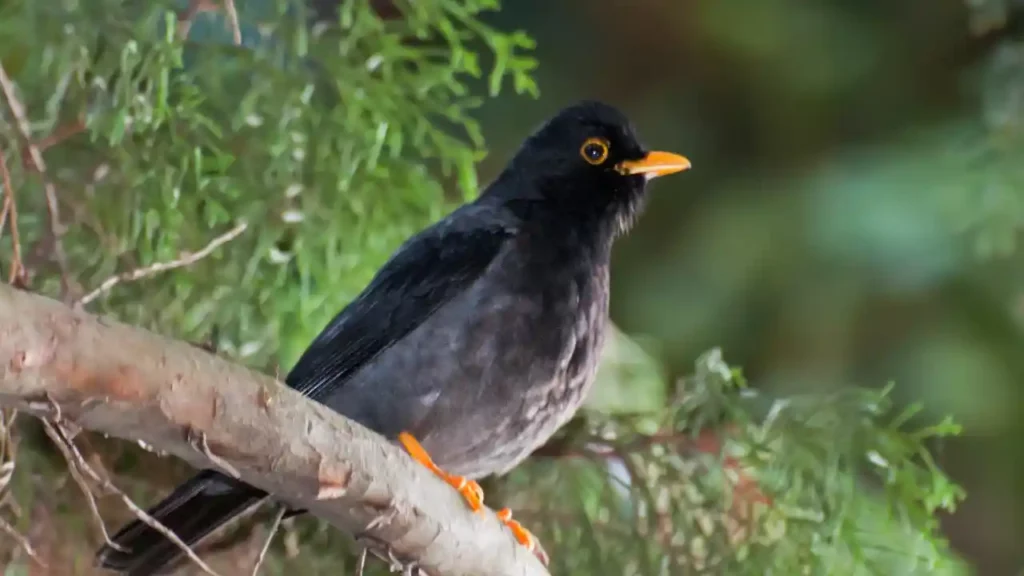
The discontinuous range of this well-dressed thrush extends from north-eastern Brazil to northern Colombia. In contrast to their mostly-black bodies, yellow-legged thrush males have slaty-gray backs and bellies.
This species has a highly distinct golden eye ring, legs, and bill.
Females are simple brown without many distinguishing characteristics; also watch for yellowish legs yellow bills and eye rings, a somewhat lighter belly, and some faint neck striping.
In comparison, the female Black-hooded Thrush has a bill that is yellower. mostly from 500 to 1,500 meters, but sometimes lower and higher, very widespread in woods, along margins, and in gardens.
The male’s song is made up of the melodic syllables sreep which, like the Eurasian blackbird, is fairly similar to other bird songs. The standard alarm cry is a harsh srip and an odd sweet.
Eurasian Blackbird
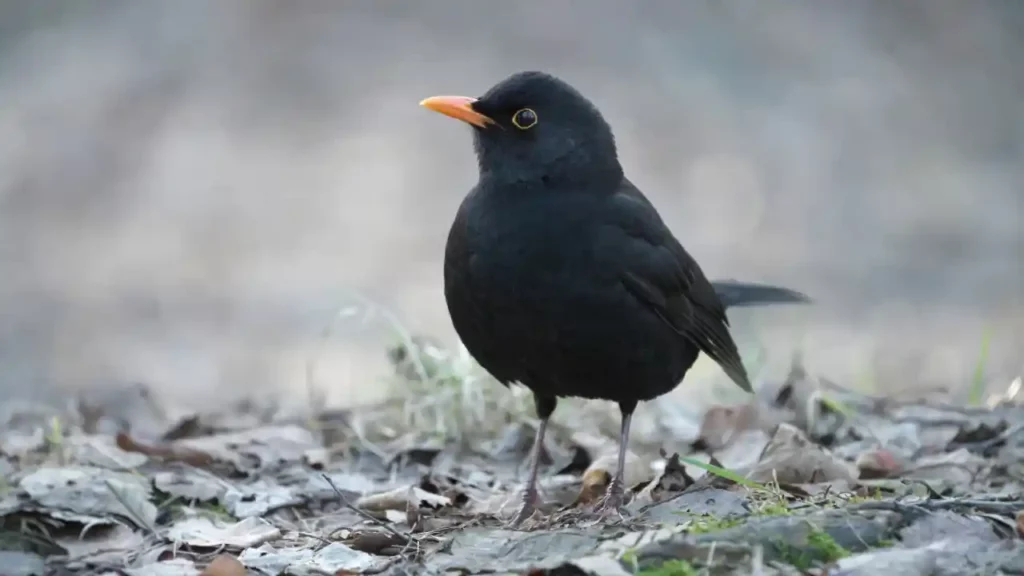
Eurasian blackbirds are members of the Turdidae family of birds, which includes several thrushes, bluebirds, and solitaires.
These birds have basic, mostly undecorated black or brown-black feathers, but their beautiful song, which has a variety of warbles, whistles, chirps, squawks, screeches, rattles, creaks, and other noises in it, is anything from simple.
These birds sing all year long and are a noticeable part of the morning symphony. Some varieties even imitate sounds from mobile phones, vehicle alarms, and other birds in their songs.
Eurasian blackbirds, like many other thrushes, are omnivorous and consume a variety of plant and animal items, notably berries, tiny fruits, moths, earthworms, slugs, and molluscs. They frequently eat fruit and suet from feeders in addition to eating the birdseed.
Indian Blackbird
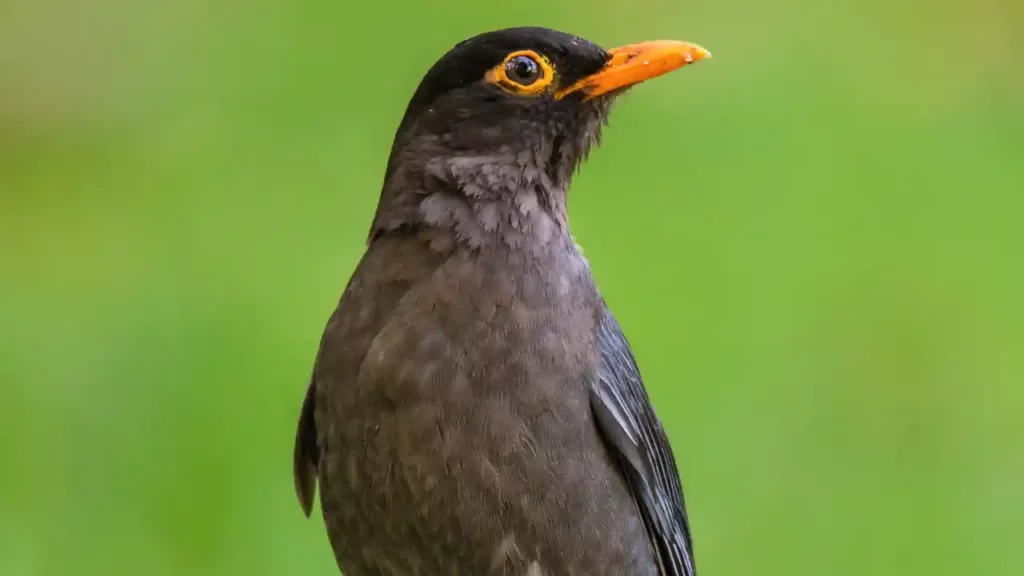
Indian Blackbird belongs to the Thrush family of birds. It is found in the south Asian continent; in the countries of India and Sri Lanka.
The blackbird was first thought to be a subspecies of the Common blackbird (Turdus merula), but because of its unique nesting location, it was eventually split and recognised as a distinct species.
The Indian blackbird has a prominent vivid and wide eye ring and measures approximately 7.5-7.9 in in length.
It should be emphasized that the bird may be easily distinguished from its comparable equivalent, the Common blackbird, based on the shape of its wings, the size of its torso, its call, and the color of its eggs.
The Indian blackbird consumes both fruits and insects. Forests, woods, and grasslands with a suitable climate make up the species’ normal habitat preferences.
Do All Black Birds Have Yellow Beaks?
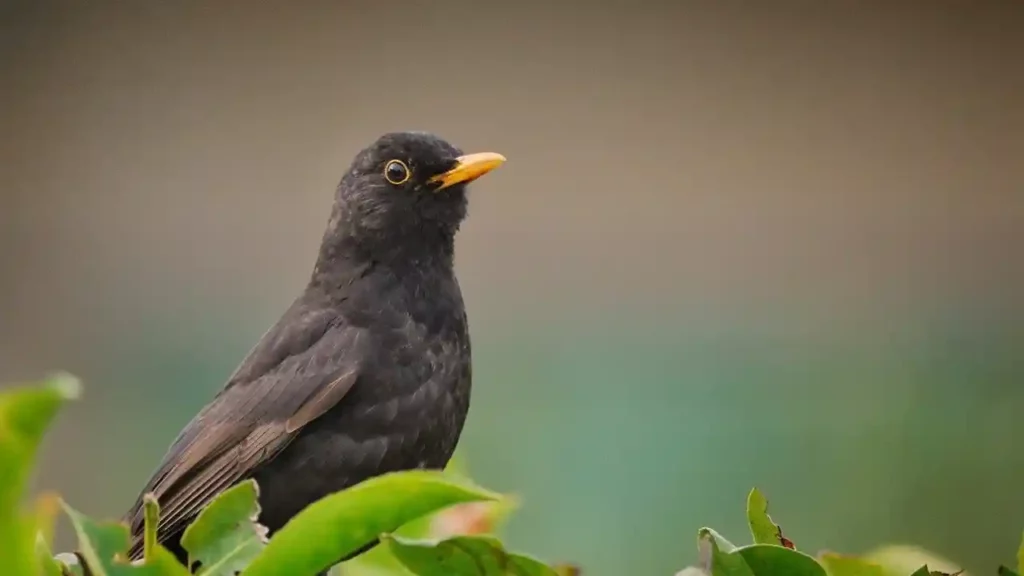
No, not all black birds have yellow beaks, the most basic example of this is crows. These zed black creatures are divinely black but their beaks are not yellow.
In fact, all ravens, rooks, and jackdaws are completely black in color but their beaks are nothing like yellow and are black just like their feathers overall.
We have studied, so far, so many black birds with yellow beaks that you might have engendered this conception, however, this is untrue.
Now, I hope you know that there are so many black birds with yellow beaks in all parts of the world and also that all black birds do not have just yellow beaks.
With so much knowledge, you will be able to point with certainty what bird you are encountering whenever you spot your next black bird with a bright yellow beak on.
Do Any Crows Have Yellow Beaks?
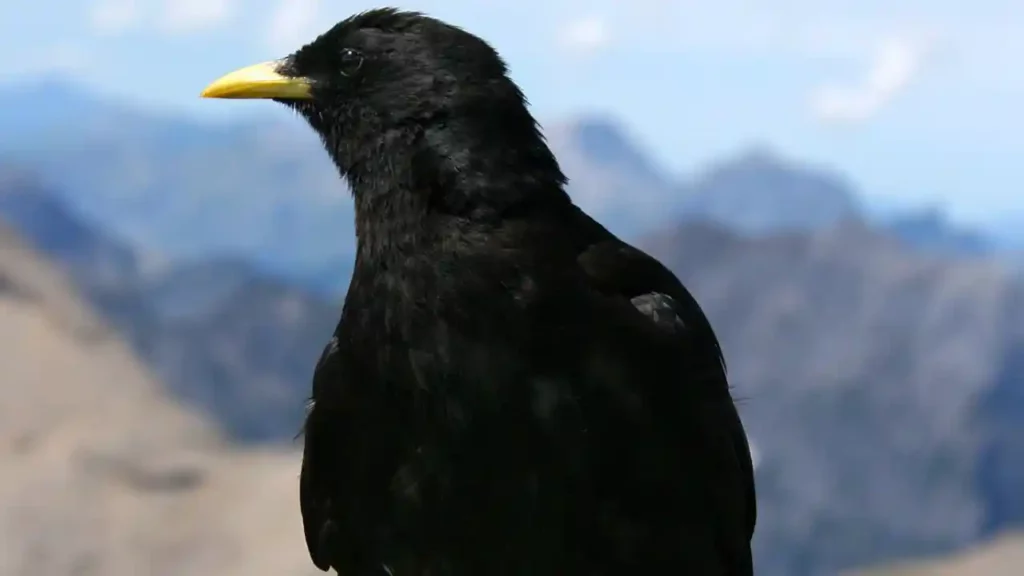
Though not as brightly colored as you would expect, some young crows do have some yellow or golden color on their bills.
The fledgling is distinguished from an adult crow by its yellow beak coloring, eyes that look gray or bluish instead of dark brown, and underdeveloped tail feathers.
Another example of a crow with a yellow beak is a Yellow-billed magpie.
They belong to the Corvid family (Jays, Magpies, Crows), hence, are crows. Only the Sacramento Valley and its surrounding areas contain this bird.
Why Do Black Birds Have Yellow Beaks?
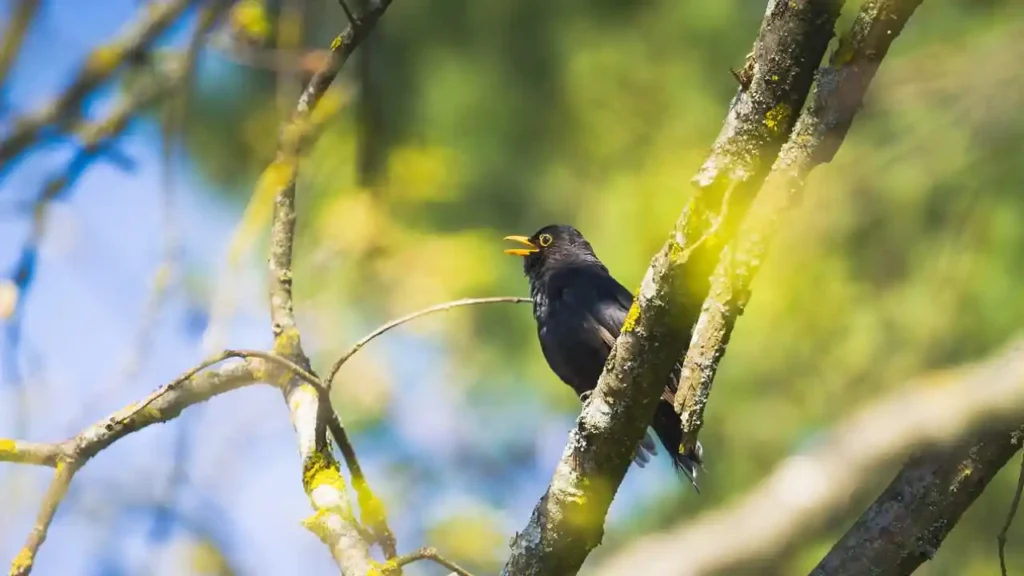
Not only blackbirds, but birds of other colors do tend to have a yellow-colored beak.
The yellow beak is due to a protein called keratin which composes the majority of the beak. The keratin’s natural hue is a drab, somewhat yellowish tint, and it appears deeper as this yellowy protein gets stacked layer after layer during the formation of the beak.
The yellow of the beak is more prominent even if a small amount of pigment is supplied to it and it isn’t covering live flesh.
A bird may have a pale to drab yellow beak if it is thin, only made of keratin, and the coloring is sparse. The color gets richer and more vibrant as it gets additional pigments.
Conclusion
Don’t be fumbled next time you spot a black bird hopping around.
Keep the basic distinctions in your head and you will be able to tell exactly which bird you are lucky to witness.
If you are somewhere in North America, it is most likely a thrush since they are most prevalent and very comfortable near human habitats.

